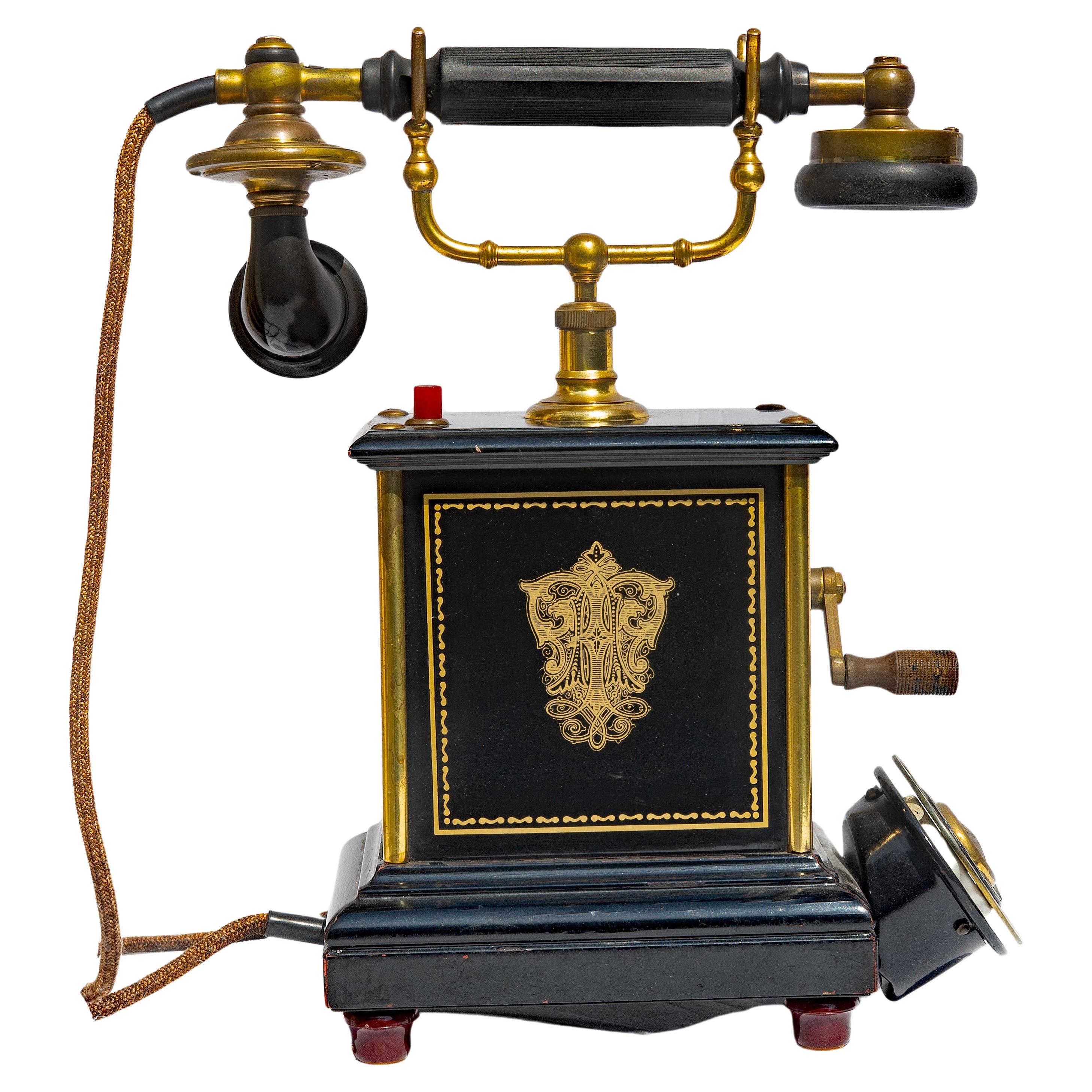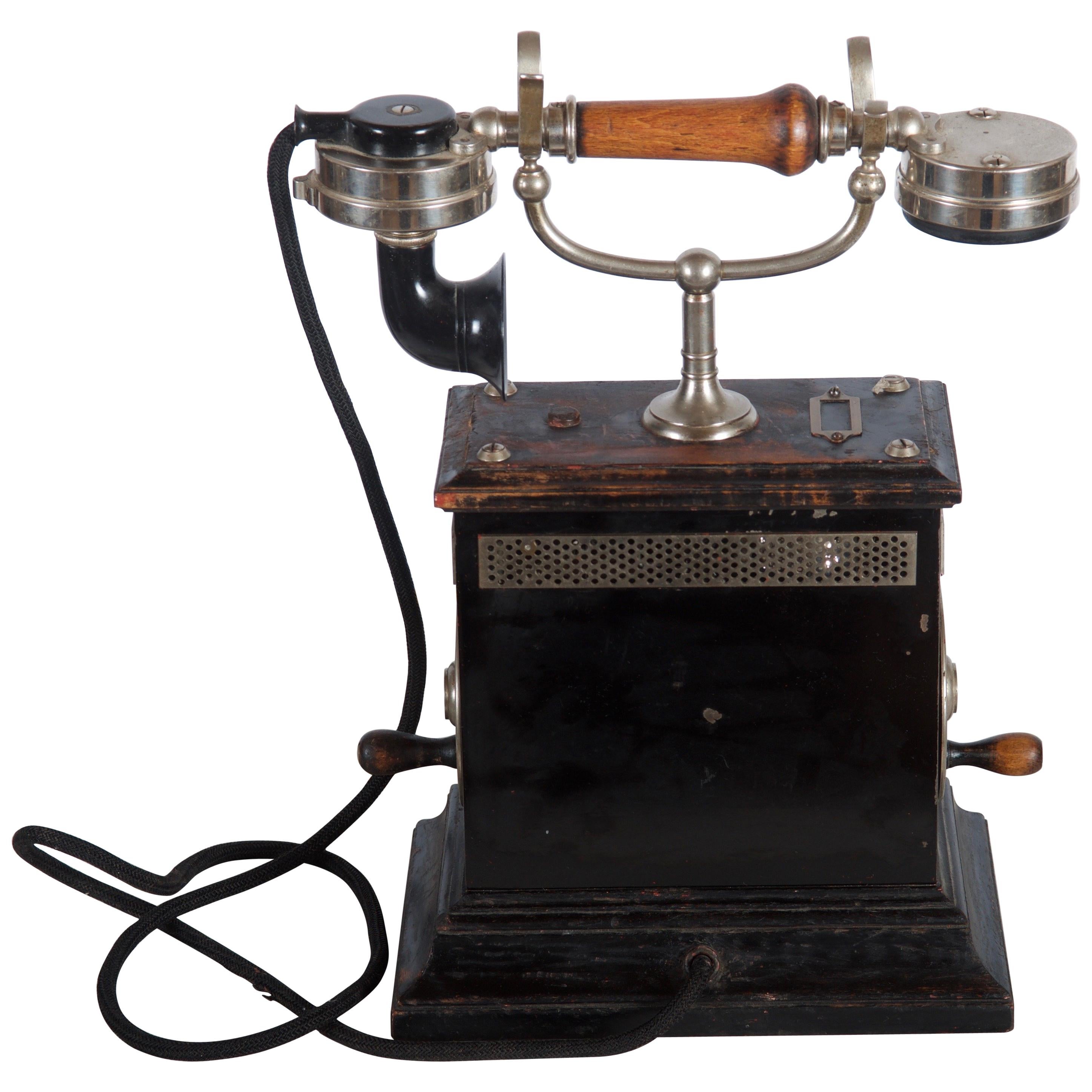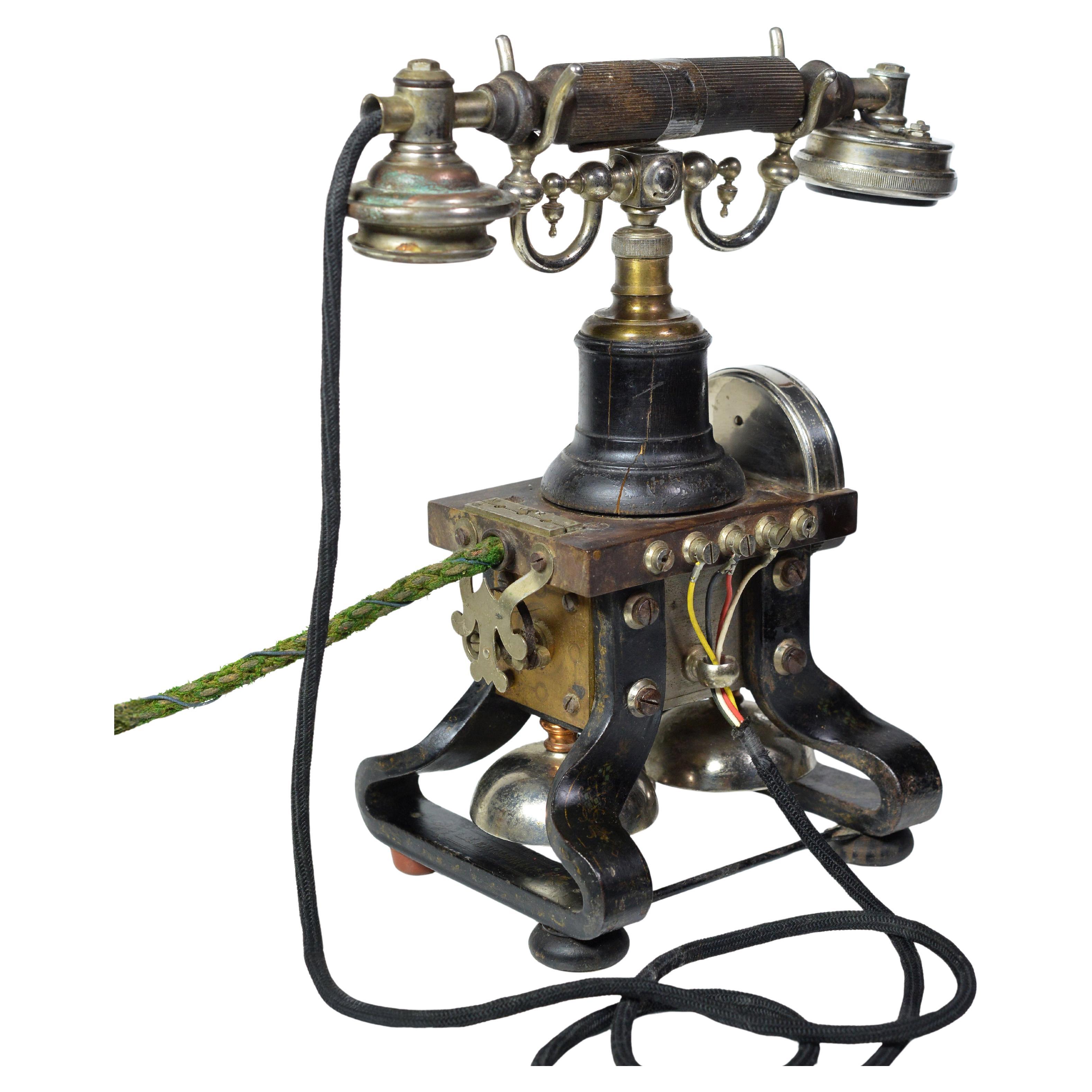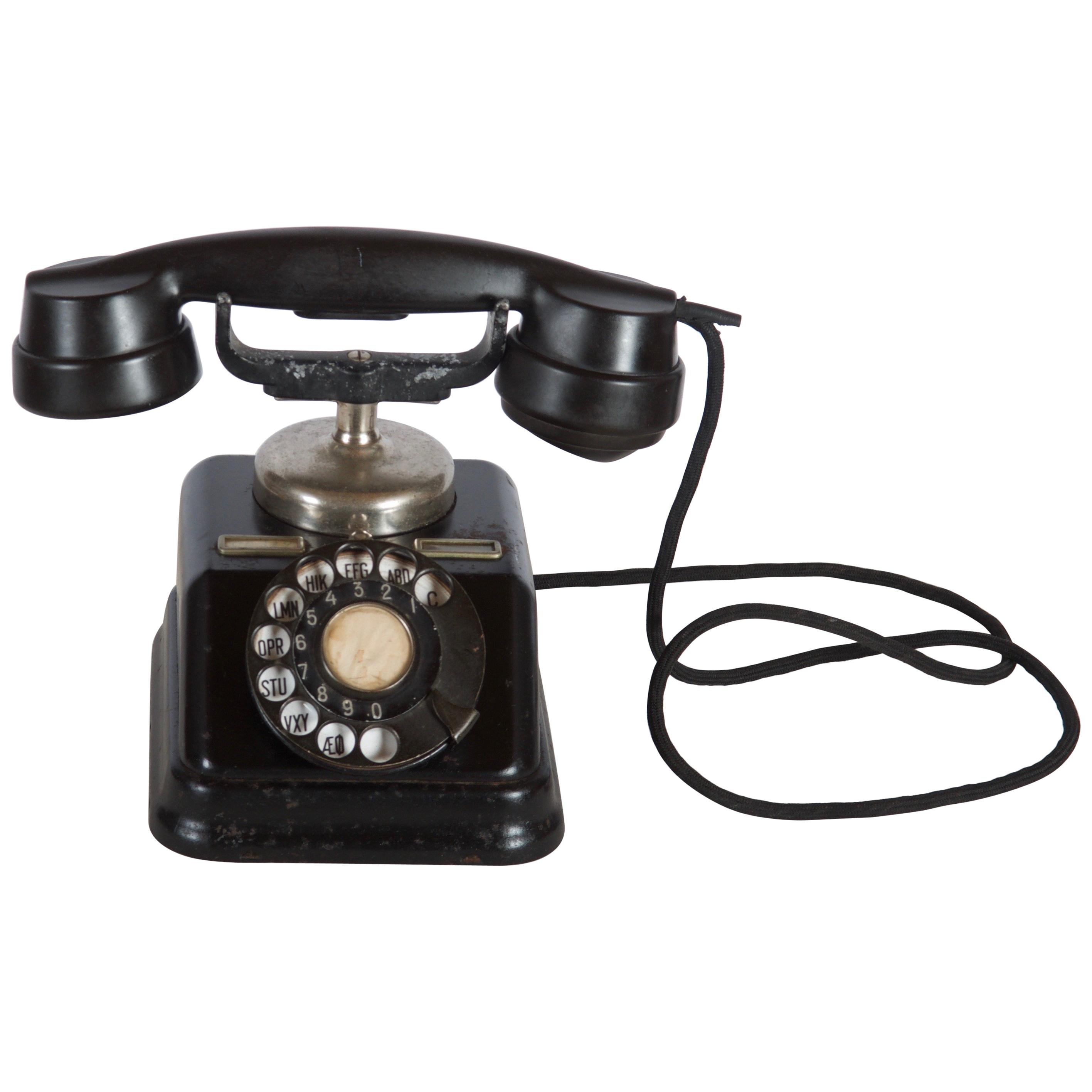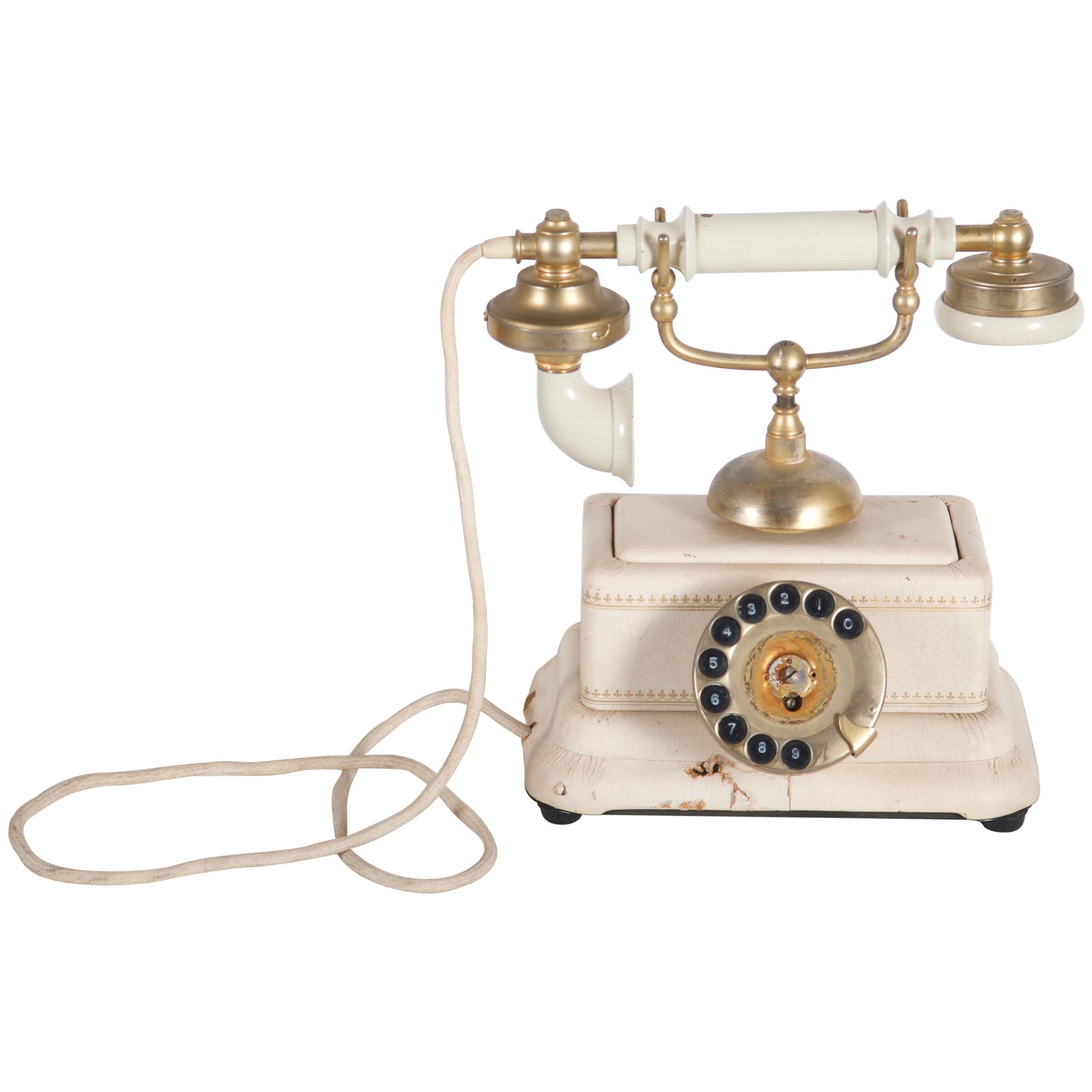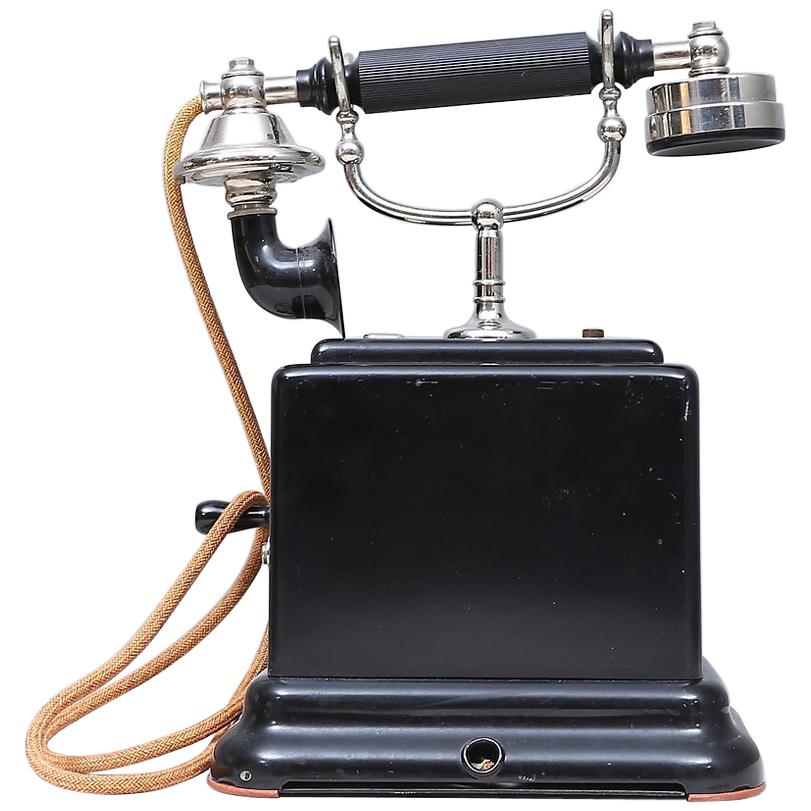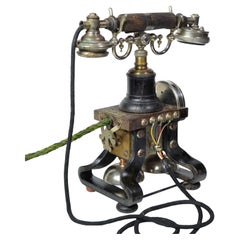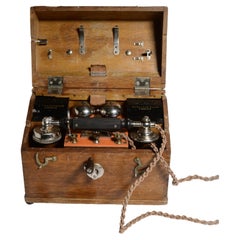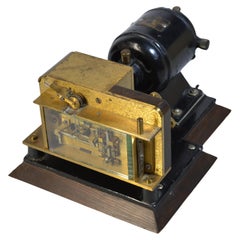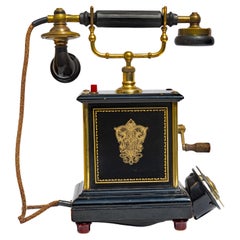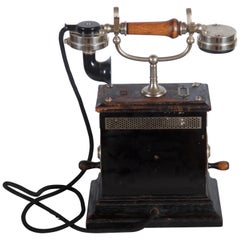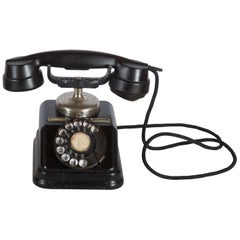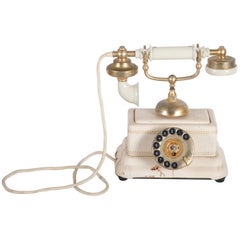Items Similar to L. M. Ericsson BC 2000 Telephone Made in 1900 Designed as Old Times Book Press
Want more images or videos?
Request additional images or videos from the seller
1 of 10
L. M. Ericsson BC 2000 Telephone Made in 1900 Designed as Old Times Book Press
$1,450
£1,093.67
€1,263.21
CA$2,031.55
A$2,258.97
CHF 1,182.61
MX$27,593.70
NOK 14,860.66
SEK 13,979.43
DKK 9,429.74
About the Item
Very rare collectible desktop telephone L. M. Ericsson model BC 2000 (Old Catalogue No. 400) for battery ringing. Exclusive and unusual design in the form of an old times book press. Framework of polished walnut. Micro-telephone RE 2002 (Old Cat. No. 520) with cord RS 7021 (Old Cat. No. 2252) and switch in the handle resting on a cradle switch, flexible cable, RS 9000 (Old Cat. No. 2084) and terminal block within Ericssons serial number that dates device on 1900 Stockholm, Sweden.
Size app.: 22.5 cm (roughly 8.9 in) high, 27 cm (roughly 10.6 in) wide, 11 cm (roughly 4.3 in) deep. Very good condition, age and usage wear plus tiny losses. Please study high-res pictures for cosmetic condition! In person actual item may appear darker or brighter than in our pictures, strictly depending on sufficient light in your environment. Weight of app. 2 kg it is going to measure some 3 kg packed for shipment.
Lars Magnus Ericsson began his association with telephones in his youth as an instrument maker. He worked for a firm which made telegraph equipment for the Swedish government agency Telegrafverket. In 1876, aged 30, he started a telegraph repair shop with help from his friend Carl Johan Andersson. The shop was in central Stockholm (No. 15 on Drottninggatan, the principal shopping street) and repaired foreign-made telephones. In 1878 Ericsson began making and selling his own telephone equipment. His phones were not technically innovative, as most of the inventions had already been made in the US. In 1878, he made an agreement to supply telephones and switchboards to Sweden's first telecom operating company, Stockholms Allmänna Telefonaktiebolag. Also in 1878, local telephone importer Numa Peterson hired Ericsson to adjust some telephones from the Bell Telephone Company. This inspired him to buy a number of Siemens telephones and analyze the technology further. (Ericsson had a scholarship at Siemens a few years earlier.) Through his firm's repair work for Telegrafverket and Swedish Railways, he was familiar with Bell and Siemens Halske telephones. He improved these designs to produce a higher quality instrument. These were used by new telephone companies, such as Rikstelefon, to provide cheaper service than the Bell Group. He had no patent or royalty problems, as Bell had not patented their inventions in Scandinavia. His training as an instrument maker was reflected in the high standard of finish and the ornate design which made Ericsson phones of this period so attractive to collectors. At the end of the year he started to manufacture telephones of his own, much in the image of the Siemens telephones, and the first product was finished in 1879. With its reputation established, Ericsson became a major supplier of telephone equipment to Scandinavia. Because its factory could not keep up with demand, work such as joinery and metal-plating was contracted out. Much of its raw materials were imported, so in the following decades Ericsson bought into a number of firms to ensure supplies of essentials like brass, wire, ebonite and magnet steel. Much of the walnut used for cabinets was imported from the US. As Stockholm's telephone network expanded rapidly that year, the company reformed into a telephone manufacturing company. But when Bell bought the biggest telephone network in Stockholm, it only allowed its own telephones to be used with it. So Ericsson's equipment sold mainly to free telephone associations in the Swedish countryside and in the other Nordic countries. The high prices of Bell equipment and services led Henrik Tore Cedergren to form an independent telephone company in 1883 called Stockholms Allmänna Telefonaktiebolag. As Bell would not deliver equipment to competitors, he formed a pact with Ericsson, which was to supply the equipment for his new telephone network. In 1918 the companies were merged into Allmänna Telefonaktiebolaget L. M. Ericsson. In 1884, a multiple-switchboard manual telephone exchange was more or less copied from a design by C. E. Scribner at Western Electric. This was legal, as the device was not patented in Sweden, although in the US it held patent 529421 since 1879. A single switchboard could handle up to 10,000 lines. The following year, L. M. Ericsson and Cedergren toured the US, visiting several telephone exchange stations to gather "inspiration". They found that US engineers were well ahead in switchboard design but Ericsson telephones were as good as any available. In 1884, a technician named Anton Avén at Stockholms Allmänna Telefonaktiebolag had combined the earpiece and the mouthpiece of a (by then) standard telephone into a handset. It was used by operators in the exchanges that needed to have one hand free when talking to their customers. Ericsson picked up this invention and incorporated it into Ericsson products, beginning with a telephone named The Dachshund.
- Attributed to:L.M. Ericsson (Manufacturer)
- Dimensions:Height: 8.9 in (22.61 cm)Width: 10.6 in (26.93 cm)Depth: 4.3 in (10.93 cm)
- Style:Art Nouveau (Of the Period)
- Materials and Techniques:
- Period:
- Date of Manufacture:e.g. 1892-1899
- Condition:Wear consistent with age and use. Minor losses. Very good condition, age and usage wear plus tiny losses. Please study high-res pictures for cosmetic condition! I.
- Seller Location:Sweden, SE
- Reference Number:1stDibs: LU8776241850592
About the Seller
No Reviews Yet
Vetted Professional Seller
Every seller passes strict standards for authenticity and reliability
1stDibs seller since 2023
13 sales on 1stDibs
Typical response time: 1 hour
- ShippingRetrieving quote...Shipping from: Sweden, Sweden
- Return Policy
Authenticity Guarantee
In the unlikely event there’s an issue with an item’s authenticity, contact us within 1 year for a full refund. DetailsMoney-Back Guarantee
If your item is not as described, is damaged in transit, or does not arrive, contact us within 7 days for a full refund. Details24-Hour Cancellation
You have a 24-hour grace period in which to reconsider your purchase, with no questions asked.Vetted Professional Sellers
Our world-class sellers must adhere to strict standards for service and quality, maintaining the integrity of our listings.Price-Match Guarantee
If you find that a seller listed the same item for a lower price elsewhere, we’ll match it.Trusted Global Delivery
Our best-in-class carrier network provides specialized shipping options worldwide, including custom delivery.More From This Seller
View AllAntique L. M. Ericsson AC110 Iron Skeleton Telephone Taxen Eiffel Dachshund #3
By L.M. Ericsson
Located in Sweden, SE
Desktop telephone model AC 110 (Old catalogue No. 375) made by L. M. Ericsson, Stockholm in period of 1895-1910. A legendary model that enjoys special attention from collectors.
Size app.: 30 cm (roughly 11.8 in) high, 27 cm (roughly 10.6 in) wide, 14 cm (roughly 5.5 in) deep. Quite good condition, age and usage wear, attritions, damages, losses of 2 feet out of 4, original finish! Please study high-res pictures for cosmetic condition! In person actual item may appear darker or brighter than in our pictures, strictly depending on sufficient light in your environment. Weight of app. 6 kg it is going to measure some 8 kg packed for shipment.
Lars Magnus Ericsson began his association with telephones in his youth as an instrument maker. He worked for a firm which made telegraph equipment for the Swedish government agency Telegrafverket. In 1876, aged 30, he started a telegraph repair shop with help from his friend Carl Johan Andersson. The shop was in central Stockholm (No. 15 on Drottninggatan, the principal shopping street) and repaired foreign-made telephones. In 1878 Ericsson began making and selling his own telephone equipment. His phones were not technically innovative, as most of the inventions had already been made in the US. In 1878, he made an agreement to supply telephones and switchboards to Sweden's first telecom operating company, Stockholms Allmänna Telefonaktiebolag. Also in 1878, local telephone importer Numa Peterson hired Ericsson to adjust some telephones from the Bell Telephone Company. This inspired him to buy a number of Siemens telephones...
Category
Antique Late 19th Century Art Nouveau Scientific Instruments
Materials
Metal, Brass, Bronze
Antique Wooden Ericsson MB 115 Crank Magneto Field Telephone 1895 С Mark 1
By L.M. Ericsson
Located in Sweden, SE
Rare, hard to find. Telephone “C” Mark 1 (Mk 1), designed by Ericsson’s of Stockholm, was the first portable military telephone. It was used in large numbers in the South African War of 1899-1902 by the Telegraph Battalion RE and became the standard field telephone...
Category
Antique Late 19th Century Swedish Art Nouveau Desks
Materials
Metal, Brass
Antique extra bell for L.M. Ericsson telephone model RA 10/2 RA 10/2000
By L.M. Ericsson
Located in Sweden, SE
RING BELLS for alternating current, Telefon AB LM Ericsson, model RA 10/2-RA 10/2000, seen in the 1930 catalogue, 2 bells in nickel-plated brass, back piece in oak, lithographed iron...
Category
Early 20th Century Swedish Art Deco Decorative Art
Materials
Metal, Brass
Antique Danish SNTS Morse Telegraph Register Wheatstone transmitter w motor
Located in Sweden, SE
The telegraph apparatus made in early 20th century and equipped with electric motor (Københavns Elektromotor Fabrik) perhaps later ca 1925.
The brass and steel instrument is state of the art creation by legendary Danish engineers. Very good, minimal age n usage wear, original state, very well preserved and likely functioning. Please study high-res pictures for cosmetic condition! Register serial 70868. app. 14,5 cm high (6”) 27 cm deep (11”) and 22 cm wide (9”). App. 6,2 kg weight it is going to measure some 9 kg packed for shipment.
Wheatstone type transmitter was produced by The Great Northern Telegraph Company (Det Store Nordiske Telegrafselskab A / S) that was founded in Denmark in June 1869. It was set up as a merger of three recently established telegraph companies initiated by Danish industrial mogul Carl Frederik Tietgen. The aim of the firm was to create a worldwide telegraph company. The former headquarters of the GNTC on The Bund, Shanghai. The starting point of The Great Northern Telegraph Company (now GN Store Nord) was a concession agreement, which C.F. Tietgen made with the Russian Tzar...
Category
Early 20th Century Danish Art Deco Historical Memorabilia
Materials
Brass, Stainless Steel
Bouillotte French Lamp Gild Bronze 4 lights Flora Motive Empire Style
Located in Sweden, SE
Stylish antique Bouillotte lamp. Square foot with a four candleholders in flora motive candleholders and adjustable fabric shade with fixation bolt in form of an arrow feather. The ...
Category
Antique Late 19th Century French Empire Table Lamps
Materials
Bronze
Louis XV Antique Boulle Clock Set Black Wood and Gild Bronze 19th century
By Japy Frères
Located in Sweden, SE
Amazing historicism clock ensemble in the style of Louis XV (late Baroque) with gorgeous architecture. This is a fine example of custom bronze work that is available on the antique market. Made in the second half of the 19th century, clock movement by Frédéric Japy (marked on cased), hand chased and gilt bronze décor of quality. Complete with 2 five-light candelabra, pendulum and key the clock itself stands on the included wooden base. Running and strikes on spring. Antique wooden clocks...
Category
Antique Late 19th Century Baroque Table Clocks and Desk Clocks
Materials
Brass, Bronze
You May Also Like
Fancy Antique Swedish Telephone Early 20th Century
Located in Rochester, NY
Fancy brass , black lacquer with gilded decoration. A work of art. Swedish Coat of arms on dial. . Circa 1910. Working condition. Made by L.M. Ericsson, Stockholm, Sweden.
Category
Early 20th Century Desk Sets
Materials
Brass
Swedish Wooden Table Phone
By L.M. Ericsson
Located in Vienna, AT
Wooden table phone, marked K. Telegfrafverkets Werkstatt Nynäshamn from the 1930s
Measures: Height about 27 cm.
Category
Vintage 1930s Swedish Desk Sets
Materials
Steel
Swedish Bakelite Table Phone
By L.M. Ericsson
Located in Vienna, AT
Bakelite table phone from the early 1950s.
Category
Vintage 1950s Swedish Desk Sets
Materials
Steel
Danish Bakelite Table Phone from the 1940s
Located in Vienna, AT
Bakelite leather covered table phone, made in Denmark in the late 1940s.
Used marks.
Category
Vintage 1940s Danish Desk Sets
Materials
Steel
Bakelite Table Phone from 1947
By L.M. Ericsson
Located in Vienna, AT
Bakelite table phone, marked K. Telegfrafverkets Werkstatt Nynäshamn from 1947
Measures: Height about 26 cm.
Category
Vintage 1940s Swedish Desk Sets
Materials
Steel
Vintage Phone, 1930s/40s
Located in Roma, IT
Vintage telephone is an original design object realized in the 1930s/40s.
A brass and wood vintage telephone.
Fair conditions due to the time.
...
Category
Early 20th Century Italian Historical Memorabilia
Materials
Brass
More Ways To Browse
Antique Hand Press
Antique 2000 Furniture
Accessory Street
Antique Book Press
Old Bell
Patent Desk
Expanding Desk
Antique Metal Bells
Brass Cradle
Copy Press
Light Wood Antique Desks
Standard Furniture Company Desk
Wood Book Desk
Swedish Cat
Antique Service Bells
Wood Book Press
Antique Wood Cradle
Antique Measuring Devices
